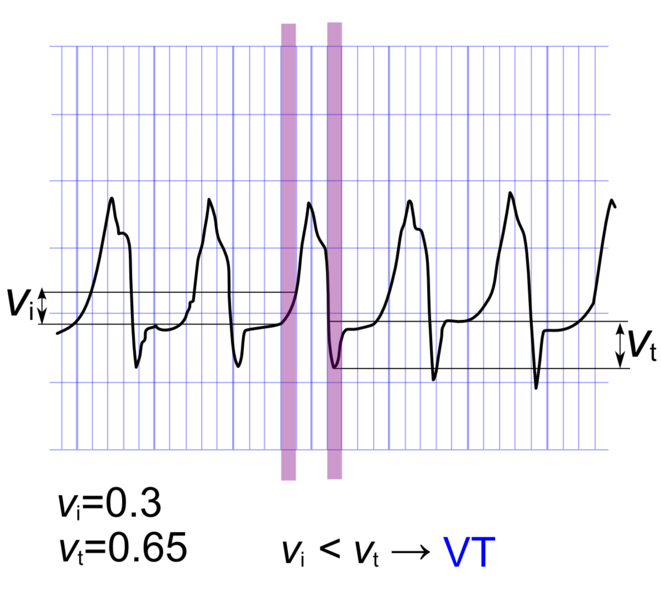Wide complex tachycardia differential diagnosis
|
Wide complex tachycardia Microchapters |
|
Diagnosis |
|---|
|
Treatment |
|
Case Studies |
|
Wide complex tachycardia differential diagnosis On the Web |
|
American Roentgen Ray Society Images of Wide complex tachycardia differential diagnosis |
|
Risk calculators and risk factors for Wide complex tachycardia differential diagnosis |
Editor-In-Chief: C. Michael Gibson, M.S., M.D. [1]; Associate Editor-In-Chief: Rim Halaby
Overview
When wide QRS tachycardia is present on ECG, it is necessary to differentiate whether it is caused by ventricular tachycardia (VT) or supraventricular tachycardia (SVT). In addition to signs on ECG, the clinical history and the age of the patient provide some clues to the nature of the wide QRS tachycardia. While older patients with prior history or myocardial infarction most likely have VT, young hemodynamically stable patients presenting for paroxysmal tachycardias most likely have SVT. Nevertheless, the main differentiating means between VT and SVT relies primarily on ECG findings for which several algorithms have been developed. Examples of these algorithms include Brugada criteria and Vereckei algorithm.[1]
Differential Diagnosis
Differentiating VT from SVT
Several ECG criteria and algorithms have been used to differentiate VT and SVT, the common one of which is Brugada algorithm. Below is a list of all algorithms:
- Brugada algorithm: sensitivity 89%, specificity 59.2%[2]
- The lead II R-wave-peak-time: sensitivity 60%, specificity 82.7%[3]
- The aVR algorithm: sensitivity 87.1%, specificity 48%[4]
- The Bayesian algorithm: sensitivity 89%, specificity 52%[5]
- The Griffith algorithm: sensitivity 94.2%, specificity 39.8%[6]
Brugada Criteria
| Absence of an RS complex in all precordial leads? | Yes? VT (SN=0.21 SP=1.0) | ||||||||||||||||||||||||||||||||||||||||
| No? | |||||||||||||||||||||||||||||||||||||||||
| R to S interval>100 ms in one precordial lead? | Yes? VT (SN=0.21 SP=1.0) | ||||||||||||||||||||||||||||||||||||||||
| No? | |||||||||||||||||||||||||||||||||||||||||
| AV dissociation? | Yes? VT (SN=0.82 SP=0.98) | ||||||||||||||||||||||||||||||||||||||||
| No? | |||||||||||||||||||||||||||||||||||||||||
| Morphology criteria for VT present both in precordial leads V1, V2 and V6? | Yes? VT (SN=0.987 SP=0.965) | ||||||||||||||||||||||||||||||||||||||||
| No? | |||||||||||||||||||||||||||||||||||||||||
| SVT (SN=0.965 SP=0.987) | |||||||||||||||||||||||||||||||||||||||||
Vereckei Criteria
An algorithm has been proposed by Vereckei and colleagues. In addition to to do the traditional criteria, the voltage change on the EKG is used as a final discriminatory criteria. In this method, the voltage change during the initial 40 ms (v(i)) and the terminal 40 ms (v(t)) of the same QRS complex is used to estimate the (v(i)) and terminal (v(t)) ventricular activation velocity ratio (v(i)/v(t)). A v(i)/v(t) > 1 suggests SVT and a v(i)/v(t) ≤ 1 suggests VT.[4]
| AV dissociation present? | Yes? VT | ||||||||||||||||||||||||||||||||||||||||
| No? | |||||||||||||||||||||||||||||||||||||||||
| Initial R wave in aVR present? | Yes? VT | ||||||||||||||||||||||||||||||||||||||||
| No? | |||||||||||||||||||||||||||||||||||||||||
| QRS morphology unlike BBB or FB | Yes? VT | ||||||||||||||||||||||||||||||||||||||||
| No? | |||||||||||||||||||||||||||||||||||||||||
| Vi/Vt≤1? | Yes? VT | ||||||||||||||||||||||||||||||||||||||||
| No? | |||||||||||||||||||||||||||||||||||||||||
| SVT | |||||||||||||||||||||||||||||||||||||||||
Calculation of Vi/Vt
Shown below is an image demonstrating the method used to calculate Vi/Vt. In this tracing, Vi/Vt is < 1 is suggestive of ventricular tachycardia according to Vereckei criteria.
ACC Algorithm
| Wide QRS complex tachycardia (QRS duration greater than 120 ms) | |||||||||||||||||||||||||||||||||||||||||||||||||||
| Regular or irregular? | |||||||||||||||||||||||||||||||||||||||||||||||||||
| Regular | Irregular | ||||||||||||||||||||||||||||||||||||||||||||||||||
| Is QRS identical to that during SR? If yes, consider: - SVT and BBB - Antidromic AVRT | Atrial fibrillation Atrial flutter / AT with variable conduction and: a) BBB or b) Antegrade conduction via AP | ||||||||||||||||||||||||||||||||||||||||||||||||||
| Vagal maneuvers or adenosine | |||||||||||||||||||||||||||||||||||||||||||||||||||
| Previous myocardial infarction or structural heart disease? If yes, VT is likely. | |||||||||||||||||||||||||||||||||||||||||||||||||||
| 1 to 1 AV relationship? | |||||||||||||||||||||||||||||||||||||||||||||||||||
| Yes or unknown | No | ||||||||||||||||||||||||||||||||||||||||||||||||||
| V rate faster than A rate | A rate faster than V rate | ||||||||||||||||||||||||||||||||||||||||||||||||||
| QRS morphology in precordial leads | VT | Atrial tachycardia Atrial flutter | |||||||||||||||||||||||||||||||||||||||||||||||||
| Typical RBBB or LBBB | Precordial leads: - Concordant - No R/S pattern - Onset of R to nadir longer than 100ms | RBBB pattern: - qR, Rs or Rr' in V1 - Frontal plane axis range from +90 degrees to -90 degrees | LBBB pattern: - R in V1 longer than 30 ms - R to nadir of S in V1 greater than 60 ms - qR or qS in V6 | ||||||||||||||||||||||||||||||||||||||||||||||||
| SVT | VT | VT | VT | ||||||||||||||||||||||||||||||||||||||||||||||||
The above algorithm is adapted from the American College of Cardiology.
References
- ↑ http://en.ecgpedia.org/wiki/Approach_to_the_Wide_Complex_Tachycardia
- ↑ Brugada P, Brugada J, Mont L, Smeets J, Andries EW (1991). "A new approach to the differential diagnosis of a regular tachycardia with a wide QRS complex". Circulation. 83 (5): 1649–59. PMID 2022022.
- ↑ Pava LF, Perafán P, Badiel M, Arango JJ, Mont L, Morillo CA; et al. (2010). "R-wave peak time at DII: a new criterion for differentiating between wide complex QRS tachycardias". Heart Rhythm. 7 (7): 922–6. doi:10.1016/j.hrthm.2010.03.001. PMID 20215043.
- ↑ 4.0 4.1 Vereckei A, Duray G, Szénási G, Altemose GT, Miller JM (2007). "Application of a new algorithm in the differential diagnosis of wide QRS complex tachycardia". Eur Heart J. 28 (5): 589–600. doi:10.1093/eurheartj/ehl473. PMID 17272358.
- ↑ Lau EW, Pathamanathan RK, Ng GA, Cooper J, Skehan JD, Griffith MJ (2000). "The Bayesian approach improves the electrocardiographic diagnosis of broad complex tachycardia". Pacing Clin Electrophysiol. 23 (10 Pt 1): 1519–26. PMID 11060873.
- ↑ Griffith MJ, Garratt CJ, Mounsey P, Camm AJ (1994). "Ventricular tachycardia as default diagnosis in broad complex tachycardia". Lancet. 343 (8894): 386–8. PMID 7905552.
